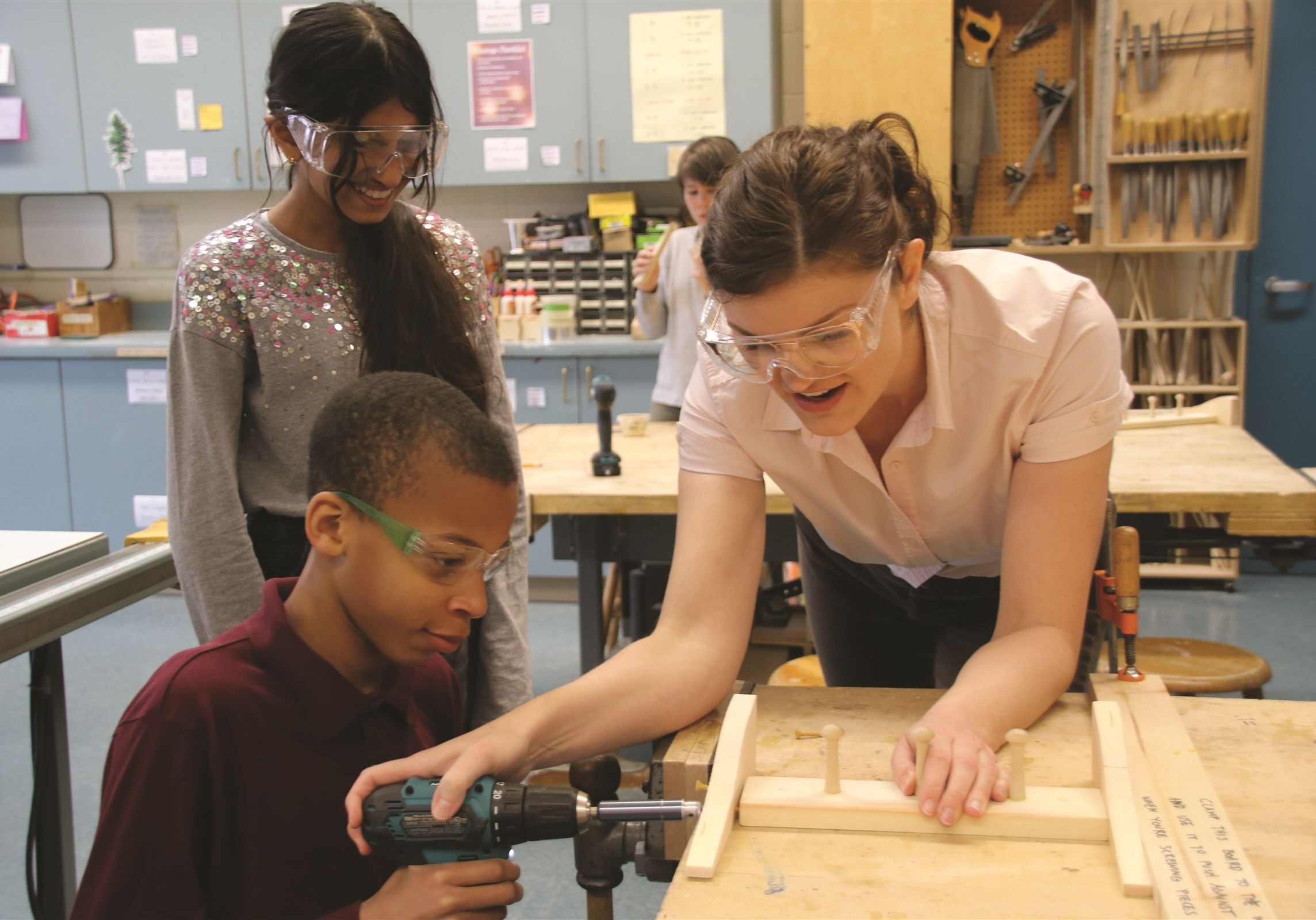Katie Jackson: Design and Woodworking Teacher

When and how did you become interested in science?
As a very young child, the idea that there were almost-perfect spheres floating in space totally fascinated me. I learned about simple machines from my dad, with whom I built a wooden go-cart, pressed apples into cider, launched rockets, and took long exposure photos of the night sky to see how the stars “moved.” I later learned about relativity in a college course called “The Physics of Time and Space.” Spoiler alert: it was really Earth that was moving.
What experiences fed your interest and helped define your direction?
In 2012, I joined the growing maker movement in Menlo Park, California at TechShop, one of America’s first formally organized makerspaces. The early days of the maker movement focused on peer-to-peer collaboration and design failure as forward movement.
Peer-to-peer collaboration was important because there were no experts yet: most technologies currently in use in Renbrook’s makerspace—3D printing, laser cutting, 3D scanning—were still in Beta or had yet to be invented. We were all just hacking our way into new ideas: the woodshop was also a metal shop, auto shop, machine shop, and graveyard for broken homemade 3D printers. I shared my woodworking skills in return for new knowledge on whatever anyone else around me was working on. Techshop also offered free courses to anyone who designed and built something there and uploaded instructions for duplicating their creations to Inventables.com. I wanted to take a Computer Aided Design course, so I designed and built a reclaimed wooden flat-pack picnic table with a planter running down the middle, and the design was uploaded.
I carry that peer-to-peer collaborative mindset into teaching in Renbrook’s makerspace. I don’t really have much more expertise than the kids I’m teaching because it’s mostly cutting-edge technology. If neither my student nor I know the answer to a problem, we research it together.
Likewise, I carry the “failure as forward movement” mindset into my teaching, a mindset initially shared by few of my students. It’s hard for post-pandemic kids to try something that might not work out. I failed a whole lot in the Bay Area. My startup, Katie Jackson Woodworks, ran out of money, and I moved back in with my mom in Connecticut. On the way across the country, I got a call from a publisher who had seen my instructions for the picnic table, which had won a couple of design contests, and he asked me to write a do-it-yourself woodworking book. After the book launch, my work was featured in Martha Stewart, Make Magazine, “Apartment Therapy,” Amazon, “MakerCast: The Podcast for Makers,” and “TreeHugger.”
What propelled you into teaching STEAM?
I directed plays at a summer camp for girls and spent far too much time on set design. I was asked to take over the woodworking department, and the camp sent me to a course for woodworking teachers of rural at-risk girls. I learned about the power of meeting kids where they are and giving girls power tools (back then, girls and tools didn’t mix as much as they do now.) Meanwhile, I had graduated from college with a degree in visual arts and education. I wasn’t interested in pursuing education at the time, so I went on to study cabinetmaking at the New England School of Architectural Woodworking.
Subsequently, I worked in cabinet shops, aerospace quality assurance, tiny house design and housing, public action, and teaching woodworking workshops to ages eight through adult at various makerspaces and Maker Faires around New England.
Later, I used my interest in education and experience in the maker movement to found the flagship STEM Makerspace at the Boys & Girls Clubs of Hartford along with Bill Saturno, who founded the first Hackerspace in Connecticut. Bill and I had different teaching styles: he was all about the tech, and I was all about the kids’ personal development, and we each learned a lot from each other.
As a teacher, how do you see middle school kids developing and using scientific thinking?
I think middle schoolers are at the most important time in their lives for developing their sense of self and life philosophy. They are seeking incredible amounts of knowledge: maybe not always the knowledge we teachers are attempting to impart, but knowledge, nonetheless. They’re already scientists: asking questions, making predictions, and drawing conclusions. As a teacher, I hope to help them with the sometimes-missed steps three and four: gathering and analyzing data.
I think it’s important for students to understand the foundations of design in order to inform their own design process. My fifth-grade STEAM class, Design/Build, introduces our newest Upper Schoolers to Renbrook’s Upper School Makerspace, where they learn about new tools, materials, and machines. Alongside building experiences, we do a year-long project called Design Through the Decades, where student groups choose a science, technology, engineering, arts, or mathematics topic and create a timeline, from the 1910s to the 2010s, of design images. The grade combines their timelines into a large grid on a bulletin board, and we spend January through June discussing the grid, sometimes with guest faculty experts. Some of my favorite topics students have chosen are military aircraft, movie special effects, radio technology, and women’s shoes: the connections between innovations in each of these categories readily emerge once students start to understand the global events and social movements happening concurrently.
What inspires you, encourages you?
After the school year ends, I work in the East Hartford Public Library Makerspace running the STEAM portion of the Parks & Recreation summer camp. I think libraries are civilization’s greatest invention, and my colleagues at EHPL: a tinkerer, a puppeteer, a mom, an artist/activist, and two high school interns, are the kind of innovative, artistic, and failure-embracing educators I aspire to be.